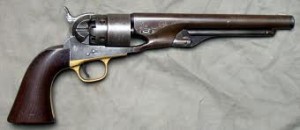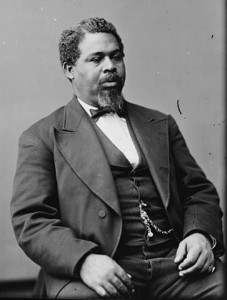A Civil War Sidearm
The 1860 Colt Model Army Revolver was a commonly used sidearm weapon in the Civil War. Cavalry, artillery, and infantry all used this revolver. It was a percussion weapon made by the Colt’s Patent Firearms Manufacturing Company in Hartford, Connecticut. Although varied pistols were used in the Civil War, the 1860 Colt Model Army Revolver was the official United States Army pistol.
Over 200,000 of the 1860 Colt Model Army Revolvers were manufactured from 1860 through 1873. From January 4, 1861 through November 10, 1863 the War Department furnished over 107,156 1860 Colt Model Army Revolvers. They became known as the New Model Army pistol and the previous 1848 version of the pistol was then called the Old Army Model.
A Revolver
The 1860 Colt Model Army Revolver was a cap and ball revolver that fired a .44 caliber cartridge with a round lead ball or a conical projectile, from an eight-inch barrel using a six-shot revolving cylinder with hammer. A rammer in front of the cylinder was used to load the sidearm. When fired, a brass percussion cap struck the hammer igniting a 30 grain black powder charge. This pistol was made of iron or steel and had a bronze trigger guard and front strap. It weighed 44oz.
The revolver’s fixed sights were usually set at 75 to 100 yards at manufacture, this being the accuracy range of the gun. Sometimes, this pistol would be adapted with a rifle-like shoulder stock, in order to improve steadiness of aiming and accuracy at further distances. At firing, the projectiles of the 1860 Colt Model Army Revolver achieved a muzzle velocity of approximately 750 feet per second.
Reliable And Popular
The 1860 Colt Model Army Revolver was the most used pistol by Union troops in the Civil War, and regarded as very reliable. It was popular with all troops in the Civil War, but was a favorite weapon of officers, cavalrymen, and artillerymen. The Confederacy recognized the capability of the 1860 Colt Model Army Revolver and produced its own knock-off version of the pistol.
The 1860 Colt Model Army Revolver’s main rival as a weapon of choice in the Civil War was the Remington Arms 1861 Remington .44 percussion revolver. The Remington looked very similar to the Colt, but it had a shorter barrel and the revolving cylinder of the Remington was enclosed.

